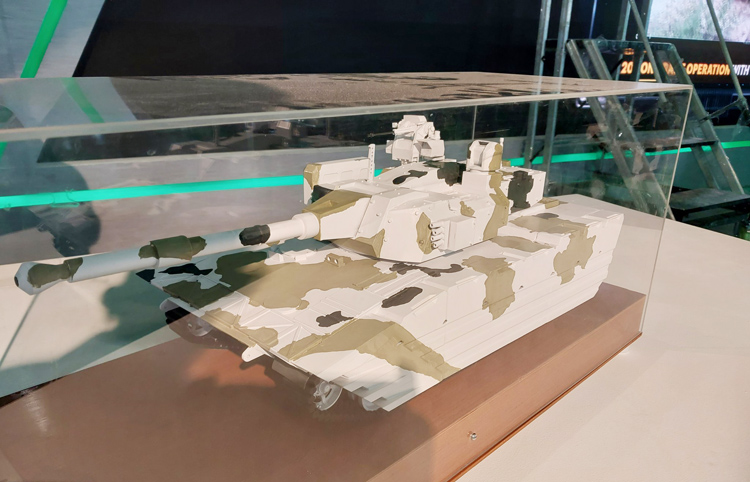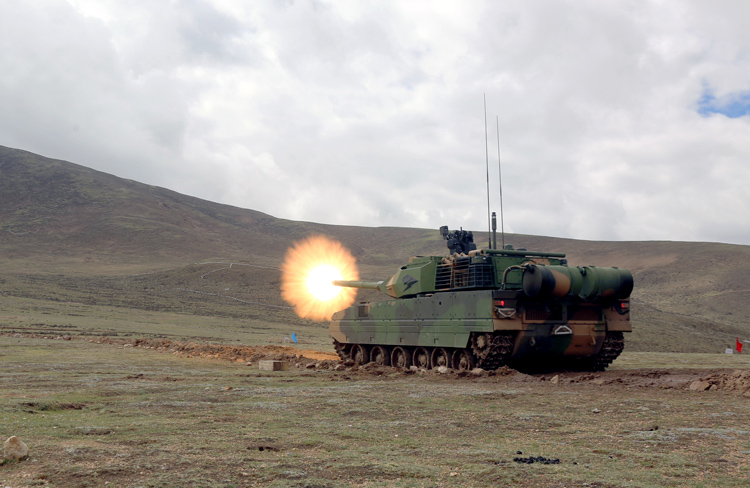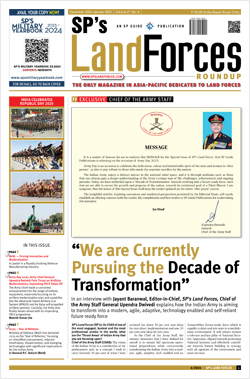INDIAN ARMED FORCES CHIEFS ON OUR RELENTLESS AND FOCUSED PUBLISHING EFFORTS

The insightful articles, inspiring narrations and analytical perspectives presented by the Editorial Team, establish an alluring connect with the reader. My compliments and best wishes to SP Guide Publications.

"Over the past 60 years, the growth of SP Guide Publications has mirrored the rising stature of Indian Navy. Its well-researched and informative magazines on Defence and Aerospace sector have served to shape an educated opinion of our military personnel, policy makers and the public alike. I wish SP's Publication team continued success, fair winds and following seas in all future endeavour!"

Since, its inception in 1964, SP Guide Publications has consistently demonstrated commitment to high-quality journalism in the aerospace and defence sectors, earning a well-deserved reputation as Asia's largest media house in this domain. I wish SP Guide Publications continued success in its pursuit of excellence.
- MoD initiates comprehensive review of Defence Acquisition Procedure 2020, pushes for defence reforms
- G7: The Swansong
- Kalinga Connect: South Asia to Polynesia
- Must Credit DRDO for Operation Sindoor, now what is next for defence R&D?
- The layered Air Defence systems that worked superbly, the key element of Operation Sindoor
- Operation Sindoor | Day 2 DGMOs Briefing
- Operation Sindoor: Resolute yet Restrained
Light Tank Zorawar: A Grandeur Effort on Indigenous MilTech Collaboration; Trials to Prove
The unfolding of Light Tank Zorawar is certainly a milestone for indigenous military technology collaboration, especially with a domestic private entity (L&T) backed up by DRDO. The light tank now in the final stage, will prove some of the complex demonstration and firepower at high altitude areas. Along with this, it must also attempt to surpass the Chinese light tank, ZTQ-15 in its objective, showing technical prowess.

In a major boost to the Indian Army, India's leading defence research agency, Defence Research and Development Organisation (DRDO) and Indian engineering conglomerate Larsen and Toubro (L&T) announced the advanced stage of trials of the Indigenous Light Tank Zorawar. The Army intends to deploy the tank in India's Ladakh region, a high-altitude mountainous plateau where the average elevation is more than 5,000 m above sea level, and over terrain that requires low-track pressure.
The acquisition process is to start by 2027 after the series of summer and winter trials, in various terrains and altitudes –from high mountains to the rugged western deserts. The trials will confirm if the Indian light tank is a match for China's light tank-- ZTQ-15 also named Type 15. In fact, China's early capability plan also looked at its border with India along the high altitude areas and the need for a tank, which can be airdropped and operate in areas, that are not accessible to China's heavier main battle tanks, such as the Type 96 and Type 99.
Building on the shorter development cycles which does prove a crucial collaboration in design and development indigenously, DRDO's Chairman Samir V. Kamat reviewed the progress made in the project at the L&T facility at Hajira in Gujarat.
The Indigenous Light Tank Zorawar, developed by DRDO and Larsen & Toubro (L&T), is undergoing advanced trials and is intended for deployment in India's high-altitude Ladakh region
In the dynamic realm of military innovation, the advent of the Light Tank Zorawar marks a significant leap forward in armoured warfare technology. Named after General Zorawar Singh, an iconic figure in Indian military history known for his strategic prowess, this tank embodies cutting-edge design principles and formidable firepower tailored for modern battlefield environments.
The key aspect of Project Zorawar is the shortest time frame of the development, after L&T had proposed a joint development with DRDO in 2021. Post Galwan-crisis, the government sanctioned the DRDO's proposal for the indigenous design and development of light tanks with key industry partner L&T in March 2022. The tank will be produced in phases, with 59 units manufactured by DRDO and L&T, while the remaining 295 will be produced under the 'Make-1' category mandated in the DAP 2020.
That, the Indian Army has finally put forth a standard (Bold and advanced but workable GQRS) and the DRDO with L&T joining such efforts, proposes a future roadmap for next-generation platforms and systems to be designed and built indigenously with efficient private domestic entities.

One of the early proponents of the light tank for Indian Army, Major General Pawan Anand (Retd) has talked about the urgent need for such a light tank for mountain warfare, even before the Galwan crisis. General Anand explained that the need for a light tank has been felt again after the Army discarded the AMX30s, and the northern border has been in focus for the last three decades.
"Let us also remember how tanks appearing suddenly in the ZojiLa areas during the 1948 operations against the Pakistanis yielded disproportionate results. The PLA (The People's Liberation Army) tanks in Moldo posed a threat to the Indian Army post-Galwan, and our T90s did meet the requirement, albeit inefficiently," Major General Anand remarked, as he reminded the efficacy and the urgency of the light tank today.
How rigorous have the tests and trials been?
Major General Anand who has closely seen the impossible mountainous terrain in high passes of Ladakh and Arunachal Pradesh and the impact of the burning hot winds on the tank in the western frontier points out: "The DRDO's experience in developing the Arjun tank, and that of L&T with the K9 gun, has ensured the Zorawar has been fielded for trials about 18 months after DAC sanction. Its spiral development will place the Indian Army in a strong position against the PLA (People's Liberation Army) in the future."
"Newer technologies in Protection systems and enhanced efficiency of engines in low aspiration conditions make the light tank a potent weapon of choice in rugged high altitude areas." he adds.
The battle of tanks: Technological Specifications
Power, Mobility and Speed
According to the DRDO, the maximum weight of the light tank is 25 tonnes. The Zorawar is built for agility and swift manoeuvrability, crucial for both offensive strikes and defensive operations.
Tank Zorawar is powered by a high-performance Cummins 750/1,000 hp engine, resulting in a power-to-weight ratio of just under 40 hp/tonne. In performance, 1000hp provides enough power for manoeuvrability in the thinner atmosphere (oxygen-depleted altitude) in Ladakh. Additionally, the engine boasts impressive speed capabilities of 70 km/h with amphibious capabilities, allowing it to swiftly navigate varied terrains, from rugged mountainous landscapes to urban settings.
The acquisition process for the Zorawar is set to start by 2027 after comprehensive trials in various terrains and altitudes, aiming to match or surpass the capabilities of China's Type 15 light tank
On the other hand, China's ZTQ-15 weighs 33 tonnes which is higher in tonnage, further adding to 36 tonnes with additional slap-on armour. The ZTQ has been seen moving around the 14,000-foot-high valleys which is why China has deployed it as a part primary land attack infantry move.
The power is based on a 1000hp diesel engine which is electronically controlled and integrated into a hydro-mechanical fully automatic transmission. However, Type 15's power-to-weight ratio varied between 27 and 30 hp/tonne based on the armour setup. This tank can be used in mountain areas and operate in terrains that are inaccessible to standard main battle tanks with a weight of around 50 tonnes like the ZTZ99.
Armament:
Main Gun: Equipped with a potent 105mm rifled gun, the Zorawar packs a punch capable of neutralising both armoured vehicles and fortified positions with precision and reliability.
Secondary Armament: Complementing its primary armament are coaxial machine guns, typically 7.62mm or similar, designed for engaging infantry and light vehicles.
Chinese Type 15 is loaded with 105mm rifle gun with additional Armour-Piercing Fin-Stabilised Discarding Sabot (APFSDS), High-Explosive Anti-Tank (HEAT), and High Explosive (HE). However, it has a gun-launched anti-tank guided missile with a projectile penetration of 500mm of armoured steel at about 2,000-2,500 meters.
Protection:
Zorawar tank's armour is crafted from advanced composite materials, offering enhanced protection against ballistic threats, artillery shells, and even improvised explosive devices (IEDs). Modular armour enhancements can be tailored based on mission requirements, ensuring adaptability in diverse operational scenarios.
Here, Type 15 lacks in comparison with just a steel armour protection against small arms and shell splinters until an additional armour-packed or explosive reactive armour is opted for.
DRDO and L&T will produce the tank in phases, with 59 units initially manufactured, followed by an additional 295 units under the 'Make-1' category mandated in the DAP 2020
Communication and Surveillance:
Incorporating state-of-the-art communication systems, the Zorawar facilitates seamless integration with command centres and other combat units, fostering superior situational awareness and coordinated operations.
Advanced surveillance and targeting systems, including day/night vision capabilities and laser rangefinders, empower crew members with comprehensive battlefield intelligence.
Crew Comfort and Ergonomics:
Designed with crew comfort in mind, the interior layout of the Zorawar prioritises ergonomic efficiency, reducing crew fatigue during extended missions. Air-conditioning and advanced filtration systems ensure optimal crew conditions even in harsh environmental conditions, enhancing operational effectiveness.
Operational Versatility
The Zorawar's compact size and lightweight construction make it well-suited for a variety of roles on the battlefield:
Reconnaissance and Patrols: Its agility and reconnaissance capabilities enable it to gather vital intelligence while remaining discreet and responsive to changing threats.
Urban Warfare: Manoeuvrability and compact design make it highly effective in urban environments where streets and alleys require nimble navigation.
Support and Security: Serving as a force multiplier, the Zorawar provides crucial fire support to infantry units and serves as a deterrent against enemy incursions.
The Light Tank Zorawar represents a formidable blend of firepower, mobility, and technological sophistication. Engineered to meet the demands of modern warfare, it embodies the spirit of innovation and strategic foresight. As military landscapes evolve, the Zorawar stands poised to redefine the benchmarks of armoured warfare, ensuring tactical superiority and operational success on diverse fronts.
However, it now remains to be seen how the Zorawar Light Tank will perform with advanced lightweight armour, active protection systems, its ability to fire missiles along with its main gun ammunition, and its agility with an efficient engine in low oxygen conditions.
"Yet, the fact that this tank has found its way in so short a time is a remarkable achievement for India's public and private defence industrial capabilities and the opening up of the IA to indigenous weapon systems. We must enable all stakeholders further, even as we critique the quality and effectiveness in the battle of the new Indian tank," Gen Ananad puts forth in the quest for advanced systems and platforms for the Indian Army in view of the ever-changing complex war and battlefield.
Manish Kumar Jha is a Consulting & Contributing Editor for SP's Aviation, SP's Land Forces and SP's Naval Forces and a security expert. He writes on national security, military technology, strategic affairs & policies.





